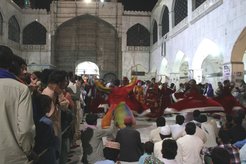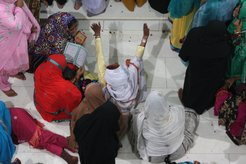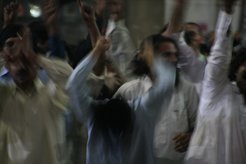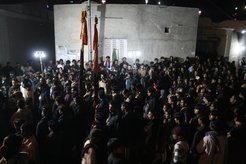Audible Spectres
Omar Kasmani
by Omar Kasmani

This text draws on three inter-related sound recordings from two affiliated saints’ shrines in Sehwan, a renowned place of pilgrimage on the banks of the river Indus in Pakistan1. The shrine of Bodlo, though much smaller, is second only to that of Lal Shahbaz Qalandar, the principal saint of Sehwan, and of whom Bodlo is the penultimate disciple. The two sites are materially and discursively conversant with each other amid flows of legend, ritual, relics and people, also sound. The sources I discuss here are sonic-lyrical offerings2 performed by pilgrims facing saints’ tombs at the two shrines. Though of varied emotional tenors and composed in different languages, these offerings move pilgrims and saints alike evoke related Islamic holy figures and point to shared scenes and spheres of affect.
The first one – recorded at the shrine of Bodlo in 2013 – documents a pilgrim’s lyrical tribute to Hussain, the grandson of the Prophet Muhammad martyred at the Battle of Karbala in 680 CE. Hussain remains a key figure of devotion for Muslims, especially the Shia in Pakistan. The Punjabi song "like Allah listens, listens Hussain” recounts his miraculous attributes and projects him as a figure of petition, one who is attentive and ever-listening. To the childless, he grants children, the man sings, and to the needy, a patron, their saviour. Hussain is as much admired for his willingness to battle against odds in these verses as he is remembered for his ultimate act of sacrifice. Puncturing the song time and again is the echo of a fakir in the background who concurrently calls out to Hussain, also to Ali, his father, the paramount imam of the Shia3. In addition to the ambient buzz of the tomb-hall, hard to miss is the sporadic clang of ankle-bells as the fakir circumambulates the tomb of Bodlo.
The second recording – also from 2013 at the same shrine – features the voice of a Shia woman pilgrim whose late afternoon offering is dedicated to Abbas, the other hero of Karbala and Hussain’s half-brother. The Urdu song of praise, "here surrender the kings" portrays the exemplary valour and devotion of Abbas who as the flag-bearer of Hussain’s army defends the family of the Prophet until his last breath. No place is like the place of Abbas, she sings, and how could it possibly be when the heaven itself leans over to kiss the flag he bears. Not only in verse, countless commemorative standards in black (alam) rise from rooftops in Sehwan making Abbas the most ubiquitously enshrined figure in town. In yet another stunning confluence of the lyrical and the local, the ‘here’ of the verse is rendered continuous with the here of the pilgrim – also of those listening to her. As she poignantly sings the refrain, "here surrender the kings,” the shrine in Sehwan is audibly imagined as the doorstep of Abbas: Where all hardships are removed. She closes the offering with chanting aloud the call to Ali.

The third recording – from 2011 – features a group of pilgrims at the shrine of Lal Shahbaz Qalandar, Sehwan’s primary site of devotion. The Seraiki song "let me be by my brother’s corpse" is a mournful text in the voice of Zainab, the sister of Hussain, who witnesses and survives the tragedy of Karbala. As the lead performer delivers the opening lines, he sets the scene of a dawning catastrophe. Others in the group can be heard wailing and sobbing before they begin to sing the lament in unison. In this latter part of the text, a bruised Zainab addresses her tormentors to turn their gazes away so that she may come to her brother’s corpse, cover his wounds with her chador, and recite Koranic verses to him on his final journey. As the men sing, Zainab’s suffering cuts through the ambient noise of the large tomb-hall, stirring emotions at the shrine.
A sense of emotion in a mise-en-scène of sound
Petitioning saints in South Asia takes very sonic forms. Yet not adequate analytical attention has been devoted to the complex auralities of saints’ places4. As I point to the sonic-emotional spheres of saints’ shrines in Sehwan, I wish to discuss the particular sonic-scenes and the affective charge of these recordings. I attend to the politics of sound, its sensibilities and affects though not in a way that privileges the shrines’ pious or ethical soundscapes5. I dwell instead in the metaphor of scenes to accentuate the fleeting and ephemeral interplay of sound, better still to capture how sonic-scenes are continually inflected by the messy and incremental character of atmospheres within which they arise and come to pass. Even at their sonic barest, these recordings reveal how sounds are political, inevitably layered, affecting but also intervene-able, in a sense airborne affects that are constantly interacting with a whole range of forms, embedded in scenes yet rising from place-specific sonicities. In other words, the affective makeup of these recordings, past their thematic content, is inflected in liaison with other sonic inputs. This means that the ordinary tinkering of tea-sellers, the guttural roar of motor-cycle rickshaws, the five calls to prayer, the daily bustle of surrounding markets as well as the occasional fights, brawls and conflicts on site are as much part of an emergent yet already drifting sonic-scene as are dissonances triggered by ritual performances themselves. Too often are acts of flagellation affectively at odds with festive offerings and celebratory processions in Sehwan; Punjabi eulogies in male voices intersect curiously with screams of women releasing co-habiting spirits in the company of saints; fakir cries pierce through the cloak of silence during the ritual bathing of saints’ tombs undertaken each morning; and emotive offerings in verse occasionally drown in the highs of drumming in shrine courtyards.
Discordant as this may sound, yet of these particular samples, it can be said that when pilgrims sing, they summon sonic mises-en-scène of affect that – among other things, in an interface with the emotional cadence of the text being recited and in the effecting presence of the place’s living, non-living and non-human participants – steer the articulation of certain feelings in potential ways within particular settings. Painful sighs or crying along mournful texts that describe the tragedy of Karbala, also the contagion it effects among its listeners in the form of participant weeping or beating of chests are in this sense oriented outbursts, if not exactly unforeseen, not entirely scripted either. My use of mise-en-scène points to the heterogeneously constituted, always-unfolding prospects of arrangement6, which is to say the delimited yet variable shapes in which the what of these texts poetically interacts with the where of their performances, generating a charged sense of time and place, feeling and mood. The generative affectivity of sonic-scenes aside, it must be said that neither are sonicities of shrines exclusively about singing nor is its stock of emotions limited to the tragedy of Karbala. In fact, saints’ places make room for pilgrims to channel their emotions in a variety of ways, both in guided and impulsive modes, involving tenors that span the tragic and the ecstatic. If anything, singing to saints, or chanting and crying in their presence gives voice to the perception that buried saints and distant historical religious persons are listening, actively and sensationally in dialogue with the world of the living.
Questions of perception are local questions. Pilgrims’ view that offerings of lyric and verse at saints’ places are primarily addressed to deceased holy persons helps us grasp how to be at specific shrines for believers is to be confirmed in the emotional knowledge that certain holy persons are here and therefore not outside their ambit of sense perception7. To the extent that turning to affect advances a localised interface of what is sensed with what is known, I pursue the idea that beyond their singular salience such individual emotive performances at Sehwani shrines reference a collectively lived situation and thus acquire historical and political charge when read in alliance or as part of a wider sonic-scene that advances the perception that Shia holy figures are aurally immediate and in that sense, sense-able, in a place like Sehwan.

A Politics of Sound: Audible spectres in cacophonies of the present
The recordings I have chosen to discuss in this text are unequivocally Shia in lyrical content. This is representative of the sample I recorded between 2009 and 2013 in Sehwan. Yet as I read the sonics of Sehwan as particularly Shia sonics, I am aware of the intellectual liberty I take especially when I would otherwise be inclined to argue that distinctions of what is Shia and Sunni in a place like Sehwan are often hard to register, at times harder to maintain. Sehwan is a place multiply haunted. An ancient river deity loiters in pre-modern saintly guises. A deep Shivaite heritage shines through its devotional landscape8. The multiple and irreconcilable genealogies of its saint linger in local and national contests over its material and spiritual legacies. Not least, its modern governance under institutions of the state is consistently at odds with its many pasts. One of the ways in which the Department of Awqaf – a subsidiary of the ministry of religious affairs that administers shrines across Pakistan – deals with such ghosts is through material taming and architectural interventions in saints’ places. The systematic removal of Shivaite relics from the shrine in Sehwan in the name of renovations is a clear example of the state’s interest in disciplining the saint and his place. In fact, the state’s anxieties around religiously-ambiguous lifeworlds like Sehwan are equally discernible in how shrines are micro-managed. Year after year, the Department’s constant policing of the shrine environs in Sehwan included painting over risqué, unsettling writings on the walls and replacing these with more shariah-neutral texts like sayings (hadith) of the Prophet Muhammad. This is particularly true of radical slogans like "ya-Ali rabb”, literally "O Ali, god", too radical even for some Shia, let alone shrine officials. Remarkably however, despite its repeated painting over, it thrives in sonic forms across Sehwan’s many shrines. To attend to the wilfulness of sound – in this case the stickiness of Ali-centred texts, chants and slogans9 – in a context like Sehwan is to attend also to what audaciously endures, lingers and withstands in face of concrete counter measures of the state. The issue of its spectrality points not as much to the past as the province of ghosts as it signals to the conditions and possibilities of their presence in the future.
To speak of Shia sonics in the context of five decades of deep and systematic patronage of the Pakistani state is on the one hand to take measure of Sehwan’s curious ascendance as a site of Shiaidentification in contemporary times10. On the other hand, it is to privilege and ally with a plurality of histories and jagged heritages that do not fit the state’s mould of Sufi shrines. In fact, the use of Shia in the title of this text is not an act of drawing borders, more a provocative prodding of perspectives that hopefully render its other histories audible. Because to record and re-present sound in and of itself is to allow its spectres to return, to render it revenant in service of a sonic hauntology. To act up in this way is especially charged with purpose when so much of the literature on Muslim saints’ places in South Asia celebrates cross-faith publics, is invested in identifying syncretic liaisons with Hindu devotion yet fails to accord Shia lifeworlds, beyond the descriptive, its rightful place in analysis of shrines – Carla Bellamy’s otherwise inspiring ethnography being a point in case11. In a sense, the category Sufi becomes a closet of choice – at the hands of the state in the Pakistani case and at times in academic writing on South Asia – whereby and wherein irregular, anti-normative, largely non-Sunni pasts and presents come to be straightened, sanitized, silenced.
The other opportunity with sound lies in methodically treating sound as form. Birgit Meyer’s compelling work in this regard queries the instrumental ways in which particular sensational forms – sonic forms included – situated within specific religious aesthetics organise relational possibilities between experiencing subjects and the transcendental12. Her argument is tied to a broader premise that views religion as a practice of mediation. Lyrical-emotional performances at saints’ shrines lend themselves to such a reading. However, what is ethnographically valid, i.e., that devotees and pilgrims emote assisted by lyric or that they address and also access the saintly through mediating performances of song might analytically be a tad too timid in an actively contested place like Sehwan. Because sensational or religious as these are, these are radical acts of refusal: Bearing witness out loud to the status of Ali as the rightful heir of the Prophet Muhammad is to take a historical-political position; invoking holy women in public spheres unsettles a largely male canon of charisma; summoning the Shia messianic figure of the occulted imam is to complicate orders of the now and the not yet, recounting the miracles of Hussain in melodies at the shrine or crying for Zainab in public is to sonically intervene in sedimenting presents. The point is that in over-determining the transcendent in our analysis, we risk ascribing only specific kinds of motivations to the religious subject. We also obscure, if not foreclose in the case of Sehwan possibilities of adequately grasping the vital scopes of emotional-affective registers that prompt, propel and empower pilgrims to infuse a historically Shivaite landscape with Shia-Alid tones under the watchful gaze of a Sunni state. Meyer views sensational forms as means to target the divine; no less important in my view is how the authority and persuasiveness of "repeatable patterns of feeling and action" (2010: 756) that she argues are induced through such forms serve equally to confirm believers in the emotional knowledge that in acting and being acted upon they can furnish ends that target the immanent and affect the political, thus disclosing other desires that complicate and at times exceed eschatological concerns.

A mourning for futures
The recordings I have presented here are samples of how dialogical and lyrical-emotional access to Shia holy figures is bridged through the medium of sound – in a sense, mere addendum to the immensely rich, even aural, aesthetics of Karbala that Hyder’s (2006) seminal work has outlined in the context of South Asia. However, by locating it at publicly administered ‘Sufi’ shrines, I locate its affective charge in the very idea that such singing to saints is not simply a past-oriented mourning of Shia tragedies. It is a forward-dawning, sensational mode of desiring13 such that by virtue of its emotional cadences authorised tenors of place come to be sonically queered, fleetingly reimagined – and this is particularly resonant when despite contrary measures of the Pakistani state, Shia faith and devotion in places like Sehwan perseveres spectrally by way of a sonic stickiness. Furthermore, to the extent that "sounds and senses can change, potentially, how we can understand what being historical means" (Berlant 2011: 36), the broader discussion this text pursues is that beyond the moment in which these are performed and recorded, lyrical-sonic performances in Sehwan effect a double emotional haunting, mourning that which (in actuality) no longer is to desiring that which (in actuality) has not yet happened14. Because in publicly sounding allegiance to Shia figures, events and temporalities, pilgrims long for other histories, they insist on other futures. They voice a historical-emotional consciousness that critiques, interrupts, and refuses a for-granted continuity of the present.
Notes
1 Sehwan in Sindh, Pakistan, attracts the country’s largest gathering of annual pilgrims. It is known for its countless saints and tomb-shrines, the most important among them being the shrine of a thirteenth century antinomian mystic, Lal Shahbaz Qalandar (d. 1274).
2 The lyrical offerings and tributes I discuss here belong to distinct poetic genres such as nauha, manqabat and qasidah however for ease of access I refer to them as songs and their recitations as singing.
3 The term imam in the Shia context refers to a divinely appointed descendent of the Prophet. This concerns the divisive conflict regarding the succession to the Prophet Muhammad upon his death in 632 CE. The Shia, i.e., the followers and supporters of Ali (cousin and son-in-law of Muhammad) consider him the first divinely appointed, rightful successor of the Prophet. In 680 CE, when Ali’s son Hussayn refused to give allegiance to the caliph of the time, he was martyred at the Battle of Karbala in present day Iraq. The tragedy forms the single most significant historic event for Shia Muslims.
4 While there is an emergent scholarly interest in the sonics of Muslim piety, in the case of shrines this remains limited to performances of official shrine music (for instance, drumming, dhamal and qawwali).
5 In a study of audio-cassette sermons in Cairo, Hirschkind examines the sensibilities and affects of an ethical soundscape contributing to the cultivation of a pious life and moral self-fashioning. For more, see Charles Hirschkind, The Ethical Soundscape: Cassette Sermons and Islamic Counter Publics (2006, New York: Columbia University Press).
6 Arrangement here implies not fixity but potentiality. Its drift for composition and modulation does not mean that individual actors do not contribute in agentive ways within a given scene of relationality. In fact, arrangement includes possibilities of variation, even disruption. I draw on Slaby et al’s the concept of affective arrangement though I render it differently in my particular emphasis on temporality. For more, see: Jan Slaby, Rainer Muehlhoff, Philipp Wueschner, "Affective Arrangements" (Unpublished working paper. Freie Universität Berlin, 2016).
7 This refers to believers’ perception that saints are not constrained by orders of time or that they can simultaneously be present at different places at once. For more on the dialogical relationship of believers’ here with an "Elsewhere", see Amira Mittermaier, Dreams that Matter: Egyptian Landscapes of Imagination (Berkeley: University of California Press, 2011).
8 According to historians, local intellectuals as well as Sindhi nationalists, Sehwan is one of the prototypical sites in the region where Sufi shrines have coincided with or at times replaced ancient sanctuaries of Shiva worship. Present day Hindu influence and participation in the ritual life of the shrine are examples of this historical continuum.
9 I do not mean to say that all Ali-centred texts always constitute as Shia devotion especially because devotion to the figure of Ali is widely shared even if particularly distinct in some religious communities, and in the case of Sehwan, involves also Hindu followers of the saint.
10 The shrine of Sehwan was taken over by the Pakistani state in June 1960 which is about the time when the nationalisation of religious endowments was first taking effect.
11 See: Carla Bellamy, The Powerful Ephemeral: Everyday Healing in an Ambiguously Islamic Place (Berkeley: University of California Press, 2011).
12 For more, see: Birgit Meyer, "Religious Sensations. Why Media, Aesthetics and Power Matter in the Study of Contemporary Religion". (Inaugural lecture, VU University, Amsterdam, 6 October 2006).
13 For queerness as a mode of desiring, see "Introduction" in Jose Esteban Munoz, Cruising Utopia: The Then and There of Queer Futurity (New York: New York University Press, 2009).
14 Mark Fisher draws on Martin Haegglunds’ distinction to elaborate on the two directions of hauntology. For more, see: Mark Fisher, Ghosts of My Life: Writings on Depression, Hauntology and Lost Futures (Winchester: Zero Books, 2014).



